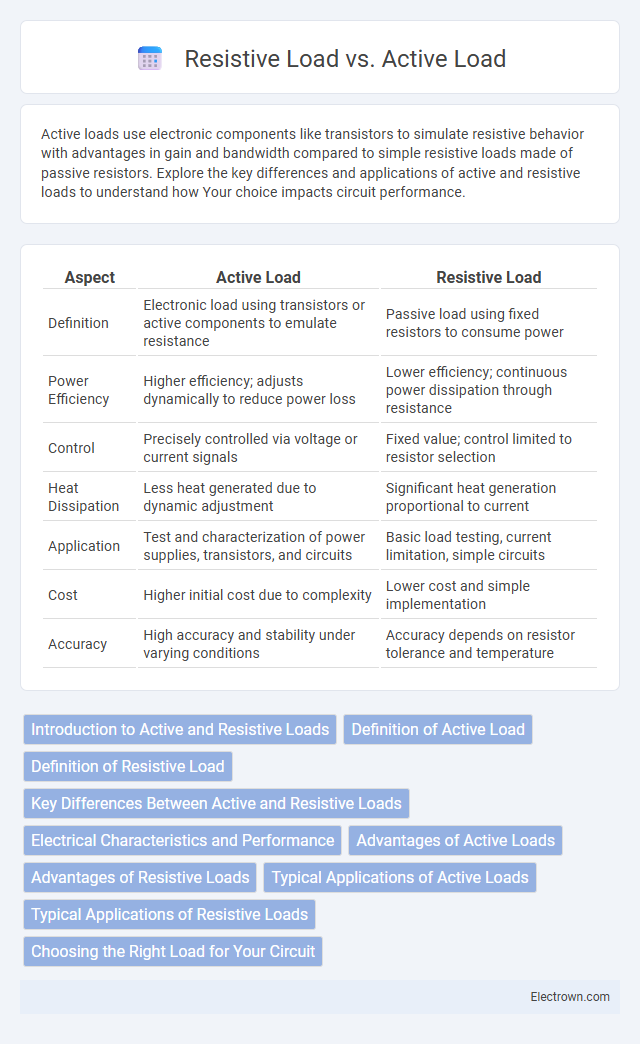Active loads use electronic components like transistors to simulate resistive behavior with advantages in gain and bandwidth compared to simple resistive loads made of passive resistors. Explore the key differences and applications of active and resistive loads to understand how Your choice impacts circuit performance.
Table of Comparison
| Aspect | Active Load | Resistive Load |
|---|---|---|
| Definition | Electronic load using transistors or active components to emulate resistance | Passive load using fixed resistors to consume power |
| Power Efficiency | Higher efficiency; adjusts dynamically to reduce power loss | Lower efficiency; continuous power dissipation through resistance |
| Control | Precisely controlled via voltage or current signals | Fixed value; control limited to resistor selection |
| Heat Dissipation | Less heat generated due to dynamic adjustment | Significant heat generation proportional to current |
| Application | Test and characterization of power supplies, transistors, and circuits | Basic load testing, current limitation, simple circuits |
| Cost | Higher initial cost due to complexity | Lower cost and simple implementation |
| Accuracy | High accuracy and stability under varying conditions | Accuracy depends on resistor tolerance and temperature |
Introduction to Active and Resistive Loads
Active loads use electronic components like transistors or operational amplifiers to simulate resistance with enhanced control and linearity, improving circuit performance and efficiency. Resistive loads consist of fixed resistors that provide a constant opposition to current flow, resulting in predictable and stable power dissipation. Understanding the differences between active and resistive loads is crucial for optimizing circuit design in applications such as amplifiers and signal processing.
Definition of Active Load
An active load refers to an electronic circuit element that mimics the behavior of a resistor using transistors or other active components, providing a controlled current or voltage instead of a fixed resistance. Unlike resistive loads, which dissipate energy as heat, active loads maintain stable operation in analog circuits by improving linearity and gain. Understanding the role of an active load can optimize your circuit design for better performance and efficiency.
Definition of Resistive Load
A resistive load refers to an electrical component or device that consumes power purely through resistance, such as incandescent bulbs or heaters, converting electrical energy into heat without reactive elements. Unlike active loads that vary with voltage or current and can include components like transistors, resistive loads maintain a constant ratio of voltage to current, described by Ohm's law. Understanding your system's resistive load is crucial for accurate power calculations and ensuring optimal circuit performance.
Key Differences Between Active and Resistive Loads
Active loads consume both real power and reactive power, often involving complex impedance with capacitive or inductive components, whereas resistive loads consume only real power with purely resistive impedance. Active loads can affect power factor and cause phase shifts between voltage and current, while resistive loads maintain voltage and current in phase, resulting in unity power factor. The dynamic behavior of active loads often requires specialized measurement and control strategies, unlike the predictable and linear response of resistive loads.
Electrical Characteristics and Performance
Active loads exhibit variable impedance and can simulate complex circuit conditions by dynamically adjusting current, enhancing testing accuracy and performance analysis. Resistive loads provide constant, linear resistance resulting in predictable voltage-current behavior but lack the flexibility of active loads for dynamic testing scenarios. Your choice between active and resistive loads impacts the precision of electrical measurements and the ability to replicate real-world operational environments effectively.
Advantages of Active Loads
Active loads offer significant advantages over resistive loads by providing higher linearity and improved gain in electronic circuits. They consume less power and occupy less silicon area in integrated circuits, making them ideal for compact and efficient designs. Your circuit performance benefits from reduced noise and better signal fidelity when using active loads.
Advantages of Resistive Loads
Resistive loads offer the advantage of predictable and stable power consumption, making them easier to analyze and control in electrical circuits. They dissipate electrical energy as heat with minimal reactive components, leading to improved energy efficiency and reduced electromagnetic interference. Their simplicity ensures consistent performance and reliability in applications such as heating elements, incandescent lighting, and simple motor resistance testing.
Typical Applications of Active Loads
Active loads are commonly utilized in analog circuit testing and integrated circuit design for simulating real-world load conditions with precision and stability. They are crucial in transistor characterization, amplifier design, and small-signal analysis due to their ability to provide variable and high-resistance loads without power dissipation issues typical of resistive loads. Active loads enhance accuracy in performance measurements and enable efficient biasing in operational amplifiers and current mirrors.
Typical Applications of Resistive Loads
Resistive loads are commonly used in heating elements, incandescent lighting, and simple electrical circuits requiring stable resistance and predictable power dissipation. These loads convert electrical energy directly into heat or light without causing phase shifts, making them ideal for household appliances and basic electronic devices. Their straightforward behavior ensures accurate performance in electric stoves, toasters, and filament-based bulbs.
Choosing the Right Load for Your Circuit
Selecting between an active load and a resistive load depends on your circuit's accuracy and power efficiency needs. Active loads, composed of transistors and operational amplifiers, provide highly precise current regulation with minimal power dissipation, ideal for testing and amplification applications. Resistive loads, made from fixed resistors, offer simplicity and stability, making them suitable for general-purpose use where cost and straightforward implementation are priorities.
active load vs resistive load Infographic

 electrown.com
electrown.com